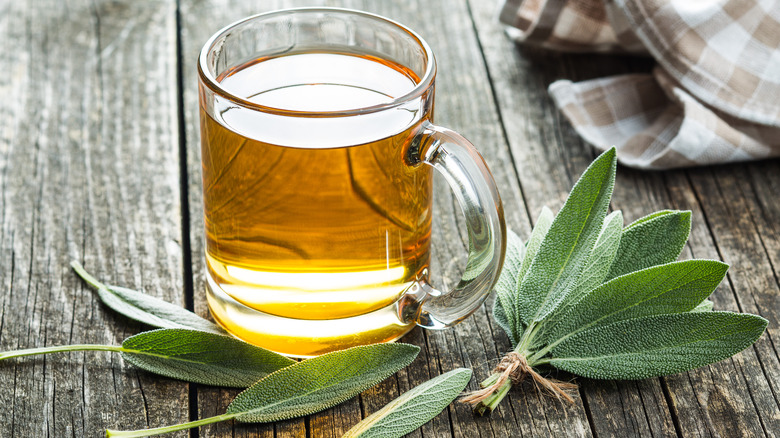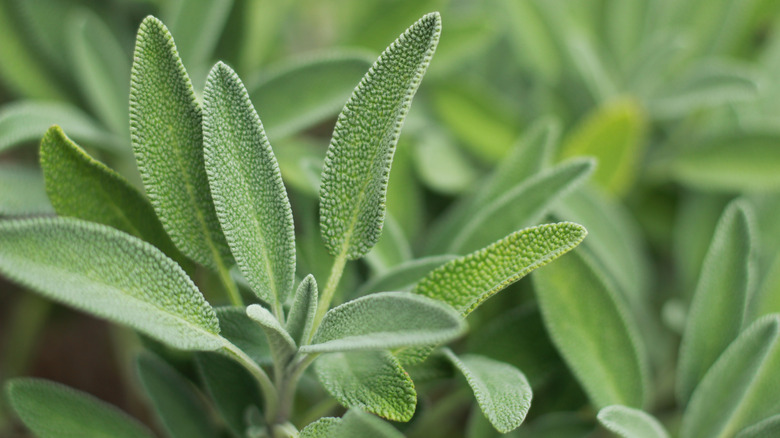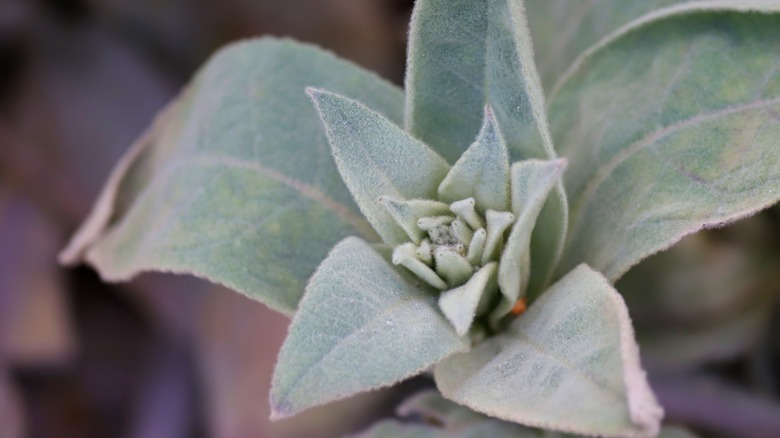Sage Has Been More Than A Culinary Staple For Thousands Of Years
A kitchen without herbs is like a body without a soul. Sage, in particular, is one of those greens you should absolutely have at all times for a variety of meals whether you need seasoning for soups, meat, veggies, or personalized spice blends. It is a particular favorite around the holiday season where aromatic herbs are an absolute necessity for the warmest most comforting meals of the year. The Pioneer Woman describes sage itself as a soft-stemmed herb characterized by its fuzzy leaves and light green color which can be purchased at farmers' markets and grocery stores both fresh and dried.
Known for its complex and pungent flavor, sage (Salvia officinalis) is a member of the mint family, according to Britannica. The common sage (or garden sage) in particular grows wild in the Mediterranean and is a favorite way to flavor poultry and pork products including chicken, turkey, and sausages. The plant has also been used medicinally and can be brewed into tea or consumed through other methods to benefit from the herb's high vitamin and mineral value, antioxidants, and antimicrobial effects (via Healthline). So, when did we start using this fantastic herb, is there more than one variety, and how did our ancestors use it?
Garden Sages (Salvia officinalis)
Chopped into boiling broths, blended into infused butter, and brewed into teas, sage has a long history in medicinal practices and culinary ones. According to the Hollywood Farmers Market, the kind of sage native to the land bordering the Mediterranean has been used throughout several ancient civilizations for millennia. There are records that the Egyptians used sage specifically to promote fertility, and the Greeks believed the herb worked as a way to preserve meat.
The Herbal Academy claims that Roman Emperor Nero's physician, Dioscorides, noted that sage, during the age of the Roman Empire, was considered one of the most important herbs in use. Sage played a key role in stanching bleeding, curing ulcers, and making teas promoting throat and brain health (they believed it made memory better). The Emperor of the Romans, Charles the Great, even commanded all the monasteries under his rule to grow sage. The herb was infused into many different medicinal beverages such as wine and spirits to aid digestion and give us some of our favorite digestifs.
The European sage varietal has a long history throughout much of the Eastern world and is still a highly popular herb in many traditional dishes today, but it isn't alone. If you had the opportunity to learn about the Native American tribes and civilizations which populated the Western continents before European invasion and following genocide, you've most likely heard about the use of white sage on the West Coast (via Flowers By The Sea).
White sage in the Americas
White sage (Salvia apiana) aka bee sage and sacred sage is native to the coastal regions of what is now Baja California. Calscape says that much like garden sage, white sage is light green with a slight silvery hue to its leaves, and is highly aromatic, but white sage only grows in a small region of the United States, making it incredibly rare. It is a key player in its ecosystem, responsible for feeding various insects and wildlife, but due to unethical harvest practices and wildfires, it is under constant threat.
According to Daily JSTOR, white sage is not only imperative to the natural world, but also carries heavy significance with the Cahuilla Band of Indians, the Chumash, the Kumeyaay, the Mahuna people, and other Indigenous communities in California and Mexico. There are records of white sage being used for religious and medicinal purposes for thousands of years, white sage was used in soaps, and cold teas, and used to season authentic cultural recipes. It was also burned during spiritual or religious ceremonies and was (and still is) used for smudging which is a cleansing process. Unfortunately, many non-Indigenous people over the centuries have appropriated Native culture and have been poaching the endangered white sage plant, and a majority of white sage on the market has been illegally stolen for profit.


